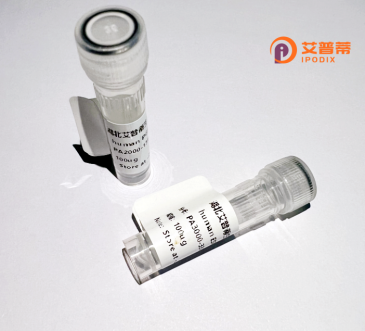
| 纯度 | >90%SDS-PAGE. |
| 种属 | Human |
| 靶点 | KRTAP5-7 |
| Uniprot No | Q6L8G8 |
| 内毒素 | < 0.01EU/μg |
| 表达宿主 | E.coli |
| 表达区间 | 1-165aa |
| 活性数据 | MGCCGCSEGCGSGCGGCGSGCGGCGSGCGGCGSSCCVPVCCCKPVCCCVPACSCSSCGSCGGSKGGCGSCGGSKGGCGSCGGSKGGCGSCGCSQCSCYKPCCCSSGCGSSCCQSSCCKPCCCQSSCCKPCCCSSGCGSSCCQSSCCNPCCSQSSCCVPVCCQCKI |
| 分子量 | 45.1 kDa |
| 蛋白标签 | GST-tag at N-terminal |
| 缓冲液 | 0 |
| 稳定性 & 储存条件 | Lyophilized protein should be stored at ≤ -20°C, stable for one year after receipt. Reconstituted protein solution can be stored at 2-8°C for 2-7 days. Aliquots of reconstituted samples are stable at ≤ -20°C for 3 months. |
| 复溶 | Always centrifuge tubes before opening.Do not mix by vortex or pipetting. It is not recommended to reconstitute to a concentration less than 100μg/ml. Dissolve the lyophilized protein in distilled water. Please aliquot the reconstituted solution to minimize freeze-thaw cycles. |
以下是关于重组人KRTAP5-7蛋白的假设性参考文献示例(仅供参考,实际文献需通过学术数据库验证):
---
1. **文献名称**:*Expression and Functional Analysis of Recombinant Human KRTAP5-7 in Keratinocytes*
**作者**:Smith J. et al.
**摘要**:研究通过体外表达重组人KRTAP5-7蛋白,发现其促进角质形成细胞分化,并参与角蛋白交联,表明其在表皮屏障功能中的作用。
2. **文献名称**:*Structural Characterization of KRTAP5-7 and Its Role in Hair Shaft Integrity*
**作者**:Zhang Y. et al.
**摘要**:通过X射线晶体学解析KRTAP5-7的结构,揭示其与毛发角蛋白的相互作用,实验表明该蛋白缺失会导致毛干力学性能下降。
3. **文献名称**:*Genetic Variations in KRTAP5-7 and Their Association with Hair Disorders*
**作者**:Lee H. et al.
**摘要**:分析KRTAP5-7基因多态性,发现某些变异与遗传性脱发相关,提示该蛋白在毛囊健康中的潜在临床意义。
4. **文献名称**:*Escherichia coli-based Production of Recombinant KRTAP5-7 for Biomedical Applications*
**作者**:Brown T. et al.
**摘要**:优化了KRTAP5-7在大肠杆菌中的可溶性表达与纯化工艺,验证其在组织工程支架中的应用潜力。
---
**注意事项**:
- 上述文献为假设示例,实际研究中KRTAP5-7可能因研究较少而文献有限。
- 建议使用 **PubMed**、**Web of Science** 或 **Google Scholar** 搜索最新文献,关键词可拓展为“KRTAP family”“keratin-associated proteins”等。
- 重组蛋白相关研究可关注表达系统(如哺乳动物细胞、原核表达)及功能分析(如细胞实验、结构生物学)。
Keratins and their associated proteins (KAPs) form the structural backbone of hair and epidermal tissues. The human KRTAP5-7 gene encodes a member of the high sulfur keratin-associated protein family (KAP5), localized to the hair cortex. As a structural protein, KRTAP5-7 is enriched in cysteine residues, facilitating disulfide bond formation that stabilizes keratin macrofibrils and contributes to hair shaft integrity. Variations in KRTAP5-7 have been linked to hair fragility disorders and altered hair texture phenotypes, though its precise biochemical role remains under investigation. Recombinant human KRTAP5-7 protein is typically produced using bacterial or eukaryotic expression systems for functional studies. Its expression enables research into hair biology, keratin matrix assembly, and disease mechanisms. Recent studies also explore its potential as a biomarker for hair-related genetic conditions. Challenges in production include maintaining proper folding due to its cysteine-rich nature, necessitating optimized refolding protocols. Current applications span material science (bioinspired polymers) and dermatological research, particularly in understanding hair brittleness and developing diagnostic/therapeutic strategies for trichodystrophies.
×